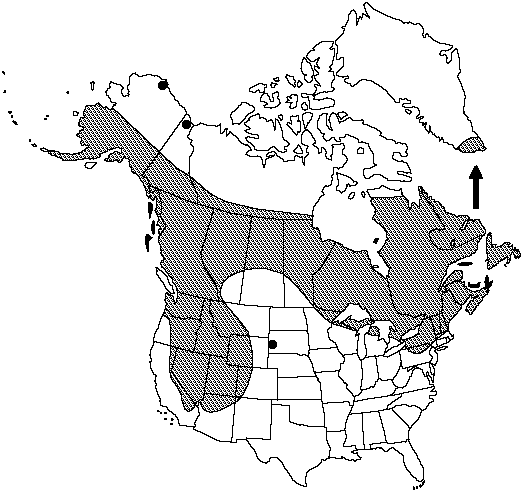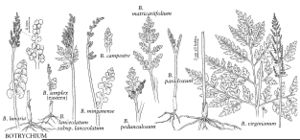Difference between revisions of "Botrychium lunaria"
J. Bot. (Schrader) 1800(2): 110. 1801.
FNA>Volume Importer |
GeoffLevin (talk | contribs) m (Fixed Nfld. and Labr. distribution to match printed version.) |
||
| (9 intermediate revisions by 3 users not shown) | |||
| Line 8: | Line 8: | ||
}} | }} | ||
|common_names=Common moonwort;botryche lunaire | |common_names=Common moonwort;botryche lunaire | ||
| − | |basionyms={{Treatment/ID/ | + | |special_status={{Treatment/ID/Special_status |
| + | |code=F | ||
| + | |label=Illustrated | ||
| + | }} | ||
| + | |basionyms={{Treatment/ID/Basionym | ||
|name=Osmunda lunaria | |name=Osmunda lunaria | ||
|authority=Linnaeus | |authority=Linnaeus | ||
| + | |rank=species | ||
| + | |publication_title=Sp. Pl. | ||
| + | |publication_place=2: 1064. 1753 | ||
}} | }} | ||
|synonyms={{Treatment/ID/Synonym | |synonyms={{Treatment/ID/Synonym | ||
|name=Botrychium onondagense | |name=Botrychium onondagense | ||
|authority=L.Underwood | |authority=L.Underwood | ||
| + | |rank=species | ||
}} | }} | ||
|hierarchy=Ophioglossaceae;Botrychium;Botrychium subg. Botrychium;Botrychium lunaria | |hierarchy=Ophioglossaceae;Botrychium;Botrychium subg. Botrychium;Botrychium lunaria | ||
| Line 23: | Line 31: | ||
}}<!-- | }}<!-- | ||
| − | --><span class="statement" id="st- | + | --><span class="statement" id="st-undefined" data-properties=""><b>Trophophore </b>stalk 0–1 mm; blade dark green, oblong, 1-pinnate, to 10 × 4 cm, thick, fleshy. <b>Pinnae</b> to 9 pairs, spreading, mostly overlapping except in shaded forest forms, distance between 1st and 2d pinnae not or slightly more than between 2d and 3d pairs, basal pinna pair approximately equal in size and cutting to adjacent pair, broadly fan-shaped, undivided to tip, margins mainly entire or undulate, rarely dentate, apical lobe usually cuneate to spatulate, notched, approximate to adjacent lobes, apex rounded, venation like ribs of fan, midribs absent. <b>Sporophores</b> 1–2-pinnate, 0.8–2 times length of trophophore. <b>2n</b> =90.</span><!-- |
-->{{Treatment/Body | -->{{Treatment/Body | ||
| + | |phenology=Leaves appearing in spring, dying in latter half of summer. | ||
|habitat=Open fields, occasionally forests in southern occurrences | |habitat=Open fields, occasionally forests in southern occurrences | ||
|elevation=0–3700 m | |elevation=0–3700 m | ||
| − | |distribution=Greenland;St. Pierre and Miquelon;Alta.;B.C.;Man.;N.B.;Nfld.;N.W.T.;N.S.;Ont.;P.E.I.;Que.;Sask.;Yukon;Alaska;Ariz.;Calif.;Colo.;Idaho;Maine;Mass.;Mich.;Minn.;Mont.;Nev.;N.H.;N.Mex.;N.Y.;Oreg.;Pa.;S.Dak.;Utah;Vt.;Wash.;Wis.;Wyo.;s South America;Eurasia;Pacific Islands in New Zealand;Australia. | + | |distribution=Greenland;St. Pierre and Miquelon;Alta.;B.C.;Man.;N.B.;Nfld. and Labr.;N.W.T.;N.S.;Nunavut;Ont.;P.E.I.;Que.;Sask.;Yukon;Alaska;Ariz.;Calif.;Colo.;Idaho;Maine;Mass.;Mich.;Minn.;Mont.;Nev.;N.H.;N.Mex.;N.Y.;Oreg.;Pa.;S.Dak.;Utah;Vt.;Wash.;Wis.;Wyo.;s South America;Eurasia;Pacific Islands in New Zealand;Australia. |
| − | |discussion=<p>Botrychium lunaria grows with many other species of Botrychium, occasionally hybridizing with them. This species, geographically the most widespread of the moonworts, has notably uniform morphology.</p> | + | |discussion=<p><i>Botrychium lunaria</i> grows with many other species of <i>Botrychium</i>, occasionally hybridizing with them. This species, geographically the most widespread of the moonworts, has notably uniform morphology.</p> |
|tables= | |tables= | ||
|references= | |references= | ||
| Line 38: | Line 47: | ||
-->{{#Taxon: | -->{{#Taxon: | ||
name=Botrychium lunaria | name=Botrychium lunaria | ||
| − | |||
|authority=(Linnaeus) Swartz | |authority=(Linnaeus) Swartz | ||
|rank=species | |rank=species | ||
| Line 45: | Line 53: | ||
|basionyms=Osmunda lunaria | |basionyms=Osmunda lunaria | ||
|family=Ophioglossaceae | |family=Ophioglossaceae | ||
| + | |phenology=Leaves appearing in spring, dying in latter half of summer. | ||
|habitat=Open fields, occasionally forests in southern occurrences | |habitat=Open fields, occasionally forests in southern occurrences | ||
|elevation=0–3700 m | |elevation=0–3700 m | ||
| − | |distribution=Greenland;St. Pierre and Miquelon;Alta.;B.C.;Man.;N.B.;Nfld.;N.W.T.;N.S.;Ont.;P.E.I.;Que.;Sask.;Yukon;Alaska;Ariz.;Calif.;Colo.;Idaho;Maine;Mass.;Mich.;Minn.;Mont.;Nev.;N.H.;N.Mex.;N.Y.;Oreg.;Pa.;S.Dak.;Utah;Vt.;Wash.;Wis.;Wyo.;s South America;Eurasia;Pacific Islands in New Zealand;Australia. | + | |distribution=Greenland;St. Pierre and Miquelon;Alta.;B.C.;Man.;N.B.;Nfld. and Labr.;N.W.T.;N.S.;Nunavut;Ont.;P.E.I.;Que.;Sask.;Yukon;Alaska;Ariz.;Calif.;Colo.;Idaho;Maine;Mass.;Mich.;Minn.;Mont.;Nev.;N.H.;N.Mex.;N.Y.;Oreg.;Pa.;S.Dak.;Utah;Vt.;Wash.;Wis.;Wyo.;s South America;Eurasia;Pacific Islands in New Zealand;Australia. |
|reference=None | |reference=None | ||
|publication title=J. Bot. (Schrader) | |publication title=J. Bot. (Schrader) | ||
|publication year=1801 | |publication year=1801 | ||
| − | |special status= | + | |special status=Illustrated |
| − | |source xml=https:// | + | |source xml=https://bitbucket.org/aafc-mbb/fna-data-curation/src/2e0870ddd59836b60bcf96646a41e87ea5a5943a/coarse_grained_fna_xml/V2/V2_820.xml |
|genus=Botrychium | |genus=Botrychium | ||
|subgenus=Botrychium subg. Botrychium | |subgenus=Botrychium subg. Botrychium | ||
|species=Botrychium lunaria | |species=Botrychium lunaria | ||
| − | |||
| − | |||
| − | |||
| − | |||
| − | |||
| − | |||
| − | |||
| − | |||
| − | |||
| − | |||
| − | |||
| − | |||
| − | |||
| − | |||
| − | |||
| − | |||
| − | |||
| − | |||
| − | |||
| − | |||
| − | |||
| − | |||
| − | |||
| − | |||
}}<!-- | }}<!-- | ||
-->[[Category:Treatment]][[Category:Botrychium subg. Botrychium]] | -->[[Category:Treatment]][[Category:Botrychium subg. Botrychium]] | ||
Latest revision as of 21:21, 20 February 2024
Trophophore stalk 0–1 mm; blade dark green, oblong, 1-pinnate, to 10 × 4 cm, thick, fleshy. Pinnae to 9 pairs, spreading, mostly overlapping except in shaded forest forms, distance between 1st and 2d pinnae not or slightly more than between 2d and 3d pairs, basal pinna pair approximately equal in size and cutting to adjacent pair, broadly fan-shaped, undivided to tip, margins mainly entire or undulate, rarely dentate, apical lobe usually cuneate to spatulate, notched, approximate to adjacent lobes, apex rounded, venation like ribs of fan, midribs absent. Sporophores 1–2-pinnate, 0.8–2 times length of trophophore. 2n =90.
Phenology: Leaves appearing in spring, dying in latter half of summer.
Habitat: Open fields, occasionally forests in southern occurrences
Elevation: 0–3700 m
Distribution

Greenland, St. Pierre and Miquelon, Alta., B.C., Man., N.B., Nfld. and Labr., N.W.T., N.S., Nunavut, Ont., P.E.I., Que., Sask., Yukon, Alaska, Ariz., Calif., Colo., Idaho, Maine, Mass., Mich., Minn., Mont., Nev., N.H., N.Mex., N.Y., Oreg., Pa., S.Dak., Utah, Vt., Wash., Wis., Wyo., s South America, Eurasia, Pacific Islands in New Zealand, Australia.
Discussion
Botrychium lunaria grows with many other species of Botrychium, occasionally hybridizing with them. This species, geographically the most widespread of the moonworts, has notably uniform morphology.
Selected References
None.
